This design utilise my last dipole speakers as a platform.
I'm surprised at how much configurable it is.

The idea is to make two alternating channels as monopole, hence the acoustic sum renders a cardioid polar response.
I need to fine tune and take outdoor polar response measurements (spring is coming yay!! ) but pleasantly hearing very solid renditions already especially of vocals and mid bass.
) but pleasantly hearing very solid renditions already especially of vocals and mid bass.
I can foresee the challenge where the wavelength is not acoustically small between woofer and mid-woofer. An asymmetrical crossover might be needed.
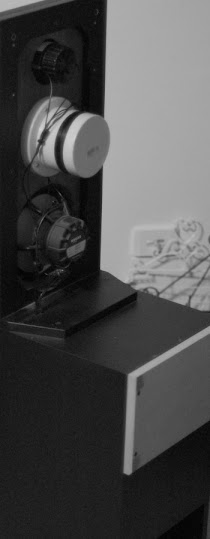
First/very early impressions:
- Great vocals. Even some recording which I thought did not sound right on dipoles
- Great lower bass.
- Sharper imaging than dipole. Not too diffused. But also not laser-sharp like waveguide
- More LFE power/feel compared to dipoles
The bad (??)
- Lost that dipole transparency "magic"
- When I move off center the sound follows ??
- LFE slams still not as great as simple sealed subs
I'm surprised at how much configurable it is.

The idea is to make two alternating channels as monopole, hence the acoustic sum renders a cardioid polar response.
I need to fine tune and take outdoor polar response measurements (spring is coming yay!!
I can foresee the challenge where the wavelength is not acoustically small between woofer and mid-woofer. An asymmetrical crossover might be needed.

First/very early impressions:
- Great vocals. Even some recording which I thought did not sound right on dipoles
- Great lower bass.
- Sharper imaging than dipole. Not too diffused. But also not laser-sharp like waveguide
- More LFE power/feel compared to dipoles
The bad (??)
- Lost that dipole transparency "magic"
- When I move off center the sound follows ??
- LFE slams still not as great as simple sealed subs
Interesting evolution, but you should not make a closed box, two much problem with internal reflection. I think if you replace the hard back side by damping material should give a more open sound. It looks like an aperiodic box  (see variovent). And another problem is your upper mid is not very at ease in a small closed space (SEAS recommends 9L).
(see variovent). And another problem is your upper mid is not very at ease in a small closed space (SEAS recommends 9L).
Thanks. I've been a patient follower of MBK's work here regarding damped midrange cardioid:
www.diyaudio.com/forums/multi-way/142691-adventures-cardioid.html?highlight=cardioid+singapore
It is very hard. The 'problem' is they become more dipole lower in the frequency. While I need dipole+monopole combination to create the Cardioid response.
The smaller enclosure of W15 should not be an issue, I think, as they are operated only from 100hz-1.5khz.
In fact I need this enclosure small to push the cavity modes higher in the frequency. They measured flat for the desired range.
... only measurements will tell. Hoping for a clear, windless weekend now
www.diyaudio.com/forums/multi-way/142691-adventures-cardioid.html?highlight=cardioid+singapore
It is very hard. The 'problem' is they become more dipole lower in the frequency. While I need dipole+monopole combination to create the Cardioid response.
The smaller enclosure of W15 should not be an issue, I think, as they are operated only from 100hz-1.5khz.
In fact I need this enclosure small to push the cavity modes higher in the frequency. They measured flat for the desired range.
... only measurements will tell. Hoping for a clear, windless weekend now
It was a great today for measurement. Unfortunately it was also a great day for the neighbours to do lawnmowing, etc. Patience was really tested! 
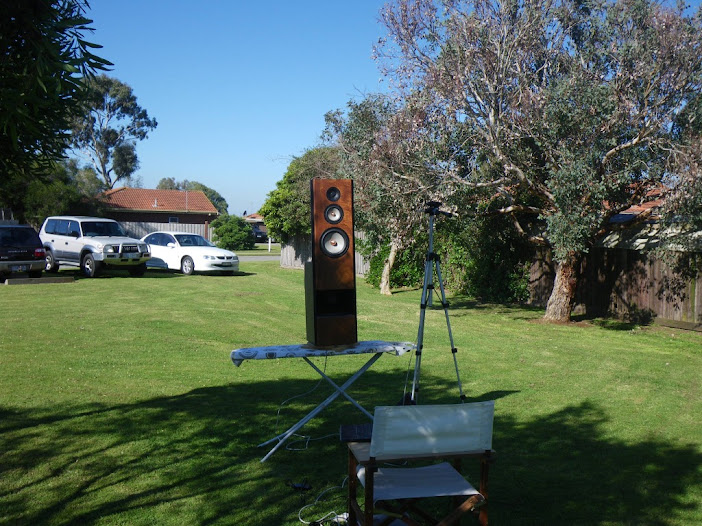
So I have the data. I think for this endeavour it's best to use Full Polar polot instead of my favourite sonograms. 360° was quite a painstaking process!
1) From 20khz down to 1.6khz (Tweeters)
Seas DXT showing great control. Mostly forward directional with a hint of hyper-cardioid at the lower end of it where it crosses with W15 at 1.5khz
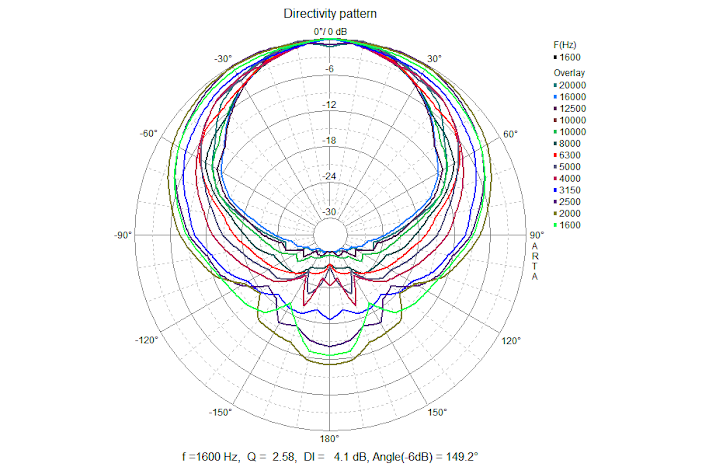
2) From 1.6khz down to 800hz
Instead of turning into Omni, W15 radiation is somewhat hyper-cardioid. At the lower end (800hz) a hint of transitioning to dipole.
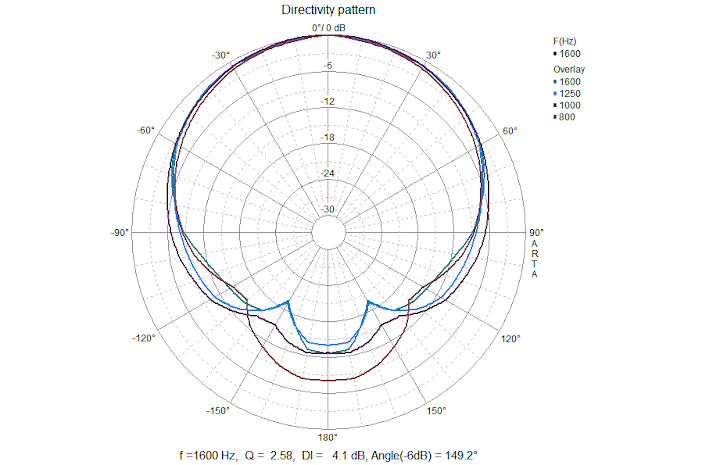
3) From 800hz down to 400hz
More influence from W22, and it formed a weak dipole. Not a full null at the sides. At 600hz, rear radiation is still -6db less.

4) From 400hz down to 20hz
From then on it gradually transition to Omni and below. This is because I changed the sub configuration to simple monopole. Audibly more slam and power. At this range the measurement accuracy is very poor.
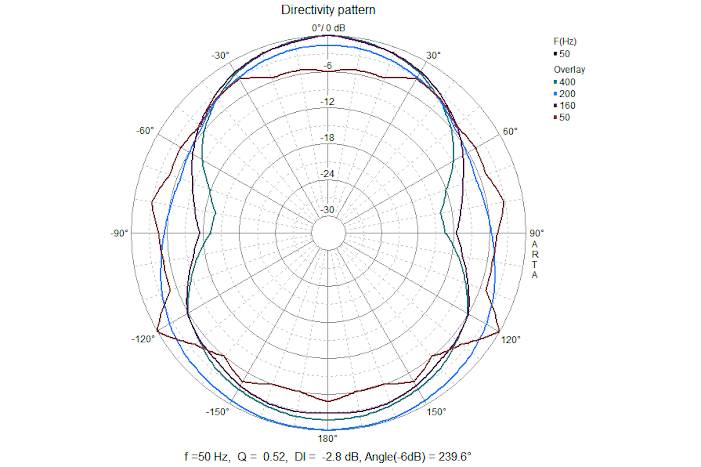
In summary
- The perfect Cardioid was never formed fully
- Forward directivity is maintain from 20khz down to 600hz. -6db less rear radiation or better.
- Then it transtition to a weak dipole to Omni. The transition is smooth and not abrupt.

So I have the data. I think for this endeavour it's best to use Full Polar polot instead of my favourite sonograms. 360° was quite a painstaking process!
1) From 20khz down to 1.6khz (Tweeters)
Seas DXT showing great control. Mostly forward directional with a hint of hyper-cardioid at the lower end of it where it crosses with W15 at 1.5khz

2) From 1.6khz down to 800hz
Instead of turning into Omni, W15 radiation is somewhat hyper-cardioid. At the lower end (800hz) a hint of transitioning to dipole.

3) From 800hz down to 400hz
More influence from W22, and it formed a weak dipole. Not a full null at the sides. At 600hz, rear radiation is still -6db less.

4) From 400hz down to 20hz
From then on it gradually transition to Omni and below. This is because I changed the sub configuration to simple monopole. Audibly more slam and power. At this range the measurement accuracy is very poor.

In summary
- The perfect Cardioid was never formed fully
- Forward directivity is maintain from 20khz down to 600hz. -6db less rear radiation or better.
- Then it transtition to a weak dipole to Omni. The transition is smooth and not abrupt.
Last edited:
An earlier work by Natehansen66 on Cardioid speakers. His method is the classical opposing monopoles with DSP delay. I had been thinking about this and glad to have found this thread.
www.diyaudio.com/forums/multi-way/259724-dsp-midrange-directivity-control-aka-kinda-cardioid.html
The Cardioid also did not form perfectly. This points to the opposing monopoles needs to be acoustically small. The challenge become somewhat similiar with dipoles at certain frequency range.
Nevertheless rear radiation is much reduced.
www.diyaudio.com/forums/multi-way/259724-dsp-midrange-directivity-control-aka-kinda-cardioid.html
The Cardioid also did not form perfectly. This points to the opposing monopoles needs to be acoustically small. The challenge become somewhat similiar with dipoles at certain frequency range.
Nevertheless rear radiation is much reduced.
Actually, I tested quite a few different configurations. The opposing monopoles (which I take it you're talking front and back) was actually the worst result due to the greater front to rear distance. I found that using either active drive units on the side, or a large vent on each side gave the widest band of useable directivity. It works best when the out of phase radiation is a 1/4 wl or so (of the highest freq of interest) behind the front baffle plane. The baffle and forward piston size dictate how high you can take it as usual.
Cool project, gain. Your website has been an inspiration since I started building speakers. I had gotten away from dipoles but it seems I'm kinda finding my way back.
Cool project, gain. Your website has been an inspiration since I started building speakers. I had gotten away from dipoles but it seems I'm kinda finding my way back.
I am very interested in this project, I was also looking at cardioid response for an adaptation of the Econowave mini or JBL AC16 which uses a 6.5" woofer and 90x90 6" waveguide and compression driver.
I was hoping to achieve a response that transitions into cardioid rather than omni as these speakers would be used for voice reinforcement and wanted to improve system gain by reducing the feedback level through he microphone.
Would it be possible to achieve this by adding another driver to the rear of the cabinet and using MiniDSP for the eq and delay or as natehansen66 has experimented with, using two smaller drivers on the sides of the cabinet?
What would I expect to see on such a small cabinet with small drivers?
I was hoping to achieve a response that transitions into cardioid rather than omni as these speakers would be used for voice reinforcement and wanted to improve system gain by reducing the feedback level through he microphone.
Would it be possible to achieve this by adding another driver to the rear of the cabinet and using MiniDSP for the eq and delay or as natehansen66 has experimented with, using two smaller drivers on the sides of the cabinet?
What would I expect to see on such a small cabinet with small drivers?
Last edited:
Actually, I tested quite a few different configurations. The opposing monopoles (which I take it you're talking front and back) was actually the worst result due to the greater front to rear distance. I found that using either active drive units on the side, or a large vent on each side gave the widest band of useable directivity. It works best when the out of phase radiation is a 1/4 wl or so (of the highest freq of interest) behind the front baffle plane. The baffle and forward piston size dictate how high you can take it as usual.
Cool project, gain. Your website has been an inspiration since I started building speakers. I had gotten away from dipoles but it seems I'm kinda finding my way back.
Thanks for joining in and sharing your experience! It looks like the bass region is easiest to tackle, and things gets difficult higher up the frequency range. Just like dipole and the complete reverse to waveguides.
Which one did you prefer btw (dipole vs cardioid)? I hope to post my observation in a few weeks time.
I am very interested in this project, I was also looking at cardioid response for an adaptation of the Econowave mini or JBL AC16 which uses a 6.5" woofer and 90x90 6" waveguide and compression driver.
I was hoping to achieve a response that transitions into cardioid rather than omni as these speakers would be used for voice reinforcement and wanted to improve system gain by reducing the feedback level through he microphone.
Would it be possible to achieve this by adding another driver to the rear of the cabinet and using MiniDSP for the eq and delay or as natehansen66 has experimented with, using two smaller drivers on the sides of the cabinet?
What would I expect to see on such a small cabinet with small drivers?
That was one of my thinking before as I have plenty of 5" drivers and waveguides to test. Let's say a 10" or 8" waveguide + Front 5.5" woofer + rear 5.5" woofer (delayed).
Assuming acoustically small = 1/2 wavelength... at 1khz it is 17cm. It might *just* make it.
It's a gradient system though, so need +6db shelving lowpass like dipoles. So it won't go very low before transitioning to the sub.
If the sub is monopole, then we get away with 4-way system. If we insist that the sub is cardioid as well, then that's a 5-way system. Very expensive!
Most of your recent projects have moved away from waveguide designs. I'm curious if you prefer the sound of conventional domes to waveguide/CD combinations? The reason I ask is my next project will be a hybrid cardoid design and I'm contemplating the high freq section.
I find conventional domes sounds fine. If not smoother than waveguides. This might be room related but I'm not fanatical to having laser-beam directivity of waveguides. I found Seas DXT seems to have the best of both world. Small, yet great directivity. It also happen to be a metal tweeter *without* phase plug and looks the part too!
Show us your design
Which one did you prefer btw (dipole vs cardioid)? I hope to post my observation in a few weeks time.
No preference at this point.....the full dipole system has been dismantled for a couple years now, and my midwoofer cardioid cabs aren't built yet. I hope to have them built (and new waveguides) before it gets too cold/snows. As chilly as it's been getting here already I better get moving!
Very interesting indeed.
Whilst I am yet to build my 'next' system in full it will be very much in line with what you have done. I have spent a lot of time playing with parts though only in steps of the frequency range using cobbled prototypes with one or two drivers rather than a full system.
As the next step involves buying the upper mid driver it will be some time before I make more progress. The trials I have done lead me to a transition in polar pattern similar to what you have in the mid region though slightly shifted down in frequency. This came from guidance of the transition at the schroeder frequency which led me to target a polar pattern transition region between 200 and 700 Hz with the directivity of cardioid 'like' at the upper end and dipole below. I have been playing with variations of lower and upper mids using closed box / U frame/ H frame with a variety of crossovers options from 1st order though bessel 4th LR4 and everything in between.
As I am yet to buld the complete system I cant confirm if the sum of the parts makes a valid whole.
By comparison to what you have done the polar pattern I have settled on is similar in the mid range though slightly shifted such that what you have at 800-1000 Hz is what I am targeting closer to 300-400Hz. This was done to achieve a constant polar pattern (not just directivity which is constant, as is the power despite the change in polar pattern) from 300-2000 Hz , coincidently also in line with voice frequencies. Driver height with its floor bounce considerations added to the mix for no good reason other than 'it is close anyway' leading to design using a dipole lwr mid crossing to a sealed upper mid at 272Hz LR4. I suspect you make the mids crossover much higher?
Whilst I am yet to build my 'next' system in full it will be very much in line with what you have done. I have spent a lot of time playing with parts though only in steps of the frequency range using cobbled prototypes with one or two drivers rather than a full system.
As the next step involves buying the upper mid driver it will be some time before I make more progress. The trials I have done lead me to a transition in polar pattern similar to what you have in the mid region though slightly shifted down in frequency. This came from guidance of the transition at the schroeder frequency which led me to target a polar pattern transition region between 200 and 700 Hz with the directivity of cardioid 'like' at the upper end and dipole below. I have been playing with variations of lower and upper mids using closed box / U frame/ H frame with a variety of crossovers options from 1st order though bessel 4th LR4 and everything in between.
As I am yet to buld the complete system I cant confirm if the sum of the parts makes a valid whole.
By comparison to what you have done the polar pattern I have settled on is similar in the mid range though slightly shifted such that what you have at 800-1000 Hz is what I am targeting closer to 300-400Hz. This was done to achieve a constant polar pattern (not just directivity which is constant, as is the power despite the change in polar pattern) from 300-2000 Hz , coincidently also in line with voice frequencies. Driver height with its floor bounce considerations added to the mix for no good reason other than 'it is close anyway' leading to design using a dipole lwr mid crossing to a sealed upper mid at 272Hz LR4. I suspect you make the mids crossover much higher?
By comparison to what you have done the polar pattern I have settled on is similar in the mid range though slightly shifted such that what you have at 800-1000 Hz is what I am targeting closer to 300-400Hz.
This, will be nice
After living with these 'quasi cardioid' for sometimes here are my quick impression:
- Very easy to design and listen. When measured flat, it sounds.... flat. Unlike dipoles when the tweeters measured flat, but clearly sounding bright and need fiddling with the level.
- They can play LOUDER without overpowering the room too soon. Due to less reverb?
- I really like the sound of Seas DXT.
- In the end I changed my subs to sealed from 20hz-80hz. Just sheer power and ease.
Seems a shame to totally lose the dipoles, but if they arn't right...
Have you considered adding a separate LFE channel using some of your achived parts bin? You probably have enough parts to keep the excellent bass dynamics of the dipole main panel and not much more would be needed to add two ( or 4) distributed subs running only below the first room mode where the downsides of a sealed system might be less apparent? If set up as a separate system it might be switched in and out as you please!
For the tweeter you have used front firing only, have you considered keeping a rear firing tw to maintain a polar pattern that is constant with frequency? I convinced myself there was a benefit in using such a rear tw tuned to 1000Hz LR4 crossover at -12dB relative to the front. The low level reduces the risks with the low crossover. Applying the same idea to your system may not be as valuable, your plots would guide to a crossover of perhaps 2500 Hz for such a rear tw. I wonder if this might be due to the W15 driver which is smaller than the 7" mid used in my trials, this larger driver may be more directional in a critical range where your system has a more constant polar pattern. Very interesting, and very useful to have such test data on a 5 inch mid, in what looks like a 300mm wide baffle?
Have you considered adding a separate LFE channel using some of your achived parts bin? You probably have enough parts to keep the excellent bass dynamics of the dipole main panel and not much more would be needed to add two ( or 4) distributed subs running only below the first room mode where the downsides of a sealed system might be less apparent? If set up as a separate system it might be switched in and out as you please!
For the tweeter you have used front firing only, have you considered keeping a rear firing tw to maintain a polar pattern that is constant with frequency? I convinced myself there was a benefit in using such a rear tw tuned to 1000Hz LR4 crossover at -12dB relative to the front. The low level reduces the risks with the low crossover. Applying the same idea to your system may not be as valuable, your plots would guide to a crossover of perhaps 2500 Hz for such a rear tw. I wonder if this might be due to the W15 driver which is smaller than the 7" mid used in my trials, this larger driver may be more directional in a critical range where your system has a more constant polar pattern. Very interesting, and very useful to have such test data on a 5 inch mid, in what looks like a 300mm wide baffle?
- Status
- This old topic is closed. If you want to reopen this topic, contact a moderator using the "Report Post" button.
- Home
- Loudspeakers
- Multi-Way
- S23 - 4 way Active Cardioid Loudspeakers